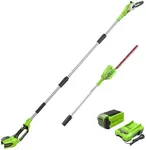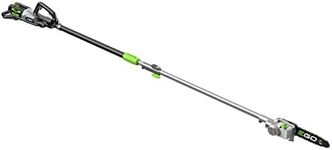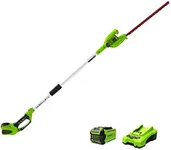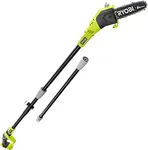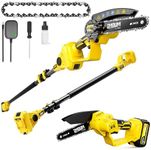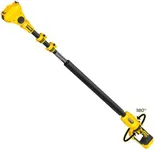Buying Guide for the Best Cordless Pole Trimmer
Choosing the right cordless pole trimmer can make your gardening tasks much easier and more efficient. A cordless pole trimmer is a versatile tool that allows you to trim and prune trees and shrubs without the hassle of cords or ladders. To find the best fit for you, it's important to understand the key specifications and how they align with your needs. Here are the main specs to consider when selecting a cordless pole trimmer.Battery LifeBattery life refers to how long the trimmer can operate on a single charge. This is important because it determines how much work you can get done before needing to recharge. Battery life is usually measured in ampere-hours (Ah). For small to medium-sized gardens, a battery life of 2-3 Ah should be sufficient. For larger gardens or more extensive trimming tasks, look for a battery life of 4 Ah or more. Consider your garden size and the frequency of your trimming tasks to choose the right battery life for you.
Pole LengthPole length is the maximum length the trimmer can extend to, allowing you to reach higher branches without a ladder. This is crucial for safety and convenience. Pole lengths typically range from 6 to 10 feet. If you have tall trees or high hedges, opt for a longer pole length. For lower shrubs and smaller trees, a shorter pole length will suffice. Assess the height of the plants you need to trim to determine the appropriate pole length.
Cutting CapacityCutting capacity indicates the maximum diameter of branches the trimmer can cut through. This is important for ensuring the trimmer can handle the thickness of the branches you need to trim. Cutting capacity is usually measured in inches. For light pruning of thin branches, a cutting capacity of up to 0.5 inches is adequate. For thicker branches, look for a cutting capacity of 1 inch or more. Consider the types of plants and the thickness of branches in your garden to choose the right cutting capacity.
WeightWeight refers to how heavy the trimmer is, which affects how easy it is to handle and maneuver. This is important for user comfort, especially during extended use. Lighter trimmers, weighing around 7-8 pounds, are easier to handle and less tiring to use. Heavier trimmers, over 10 pounds, may offer more power but can be more challenging to manage. Think about your physical strength and how long you plan to use the trimmer at a time to select the right weight.
Blade TypeBlade type refers to the design and material of the trimmer's cutting blade. This is important for the efficiency and quality of the cut. Blades can be made from steel or other durable materials and may be single or double-sided. Double-sided blades can cut in both directions, making trimming faster and more efficient. Steel blades are durable and stay sharp longer. Consider the type of plants you will be trimming and how often you will use the trimmer to choose the right blade type.
AdjustabilityAdjustability refers to the ability to change the angle of the cutting head or the length of the pole. This is important for reaching awkward angles and ensuring a comfortable working position. Some trimmers offer adjustable heads that can pivot to different angles, making it easier to trim hard-to-reach areas. Adjustable poles can be extended or shortened to suit different tasks. Think about the variety of trimming tasks you need to perform and whether adjustability would make those tasks easier.

